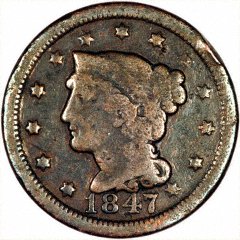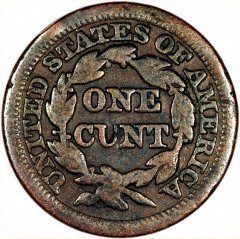| The Very Highest Quality Advice... |
| 1847 Altered US Cent |
|
| How To Navigate Our Site |

|

|
ONE CUNT
We have seen many altered coins during our forty plus years in the coin business. We acquired this particular coin sometime around 1964, and being but teenage schoolboys at the time, it appealed to our puerile sense of humour. Strangely enough it is the only coin we have ever seen with this particular alteration. Until very recently, 11th February 2004, it had disappeared somewhere, and my cousin Alan found it while clearing out some old rubbish while getting ready to move to Canada.
As you will see from the photograph the inscription on the reverse of the coin showing its value as ONE CENT has been waggishly altered to read ONE CUNT.
Apart from the obvious, it amuses us that this type of US coin is known as a "large cent", as opposed to the "small cents" introduced in 1859, which slightly extends and compounds the original humour.
Re-Engraving
Altering a coin by re-engraving the lettering or date is fairly common. It is usually done to turn a common genuine coin into an apparent rarity, with a fraudulent profit motive. As we mention above, this is the only example we can remember seeing using the graving technique for humour and amusement. We would be happy to receive other reported sightings of similar coins. All contributions (hope we spelt that correctly) gratefully received.
Taboo Words & Euphemism
We have tried to approach the use of one of the most taboo words in the English language with some sensitivity so as not to offend our viewers. As it happens, although we deplore the wanton and incorrect use of such words, we believe that many people allow themselves to be needlessly shocked when encountering such words used perfectly correctly. It is prudish to censor words used for parts of the anatomy when those words are perfectly good words which communicate their meaning clearly. We also regret the common and pretentious use of euphemisms by narrow-minded people. We trust you will not take offence at the content of this page.
Times Change
As times change, so does public perception of what is taboo or offensive. A good example of this may be to look at coins from earlier times. Many early Indian coins had as their major type or symbol a lingam on an altar. The word lingam may be familiar to those who have read the Kama Sutra, but for those who are not so widely read, we will provide enlightenment. It is the Indian word for penis. The lingam or penis shown surmounted on an alter was always an erect penis, which apparently was worshipped as the major symbol of fertility. How narrowminded we would appear to the ancient Indians when nowadays the sight of an erect penis constitutes illegal and obscene content in films, photographs and printed works. Neither were the ancient Indians the only society to feature penises on coins. Some ancient Greek, Roman, and Celtic coins featured satyrs and other male characters with an erect penis. These are usually described in educated works as ithyphallic.
Update November 2013
In November 2013 we received a telephone call and email from a lady in Canada regarding a similar coin. She has a 1859 which features an Indian head and also appears to have the same alteration.
Buying Coins
We also buy coins, please see our We Buy Coins page.
| ...at the Lowest Possible Price |
|
32 - 36 Harrowside, Blackpool, Lancashire, FY4 1RJ, England. Telephone (44) - (0) 1253 - 343081 ; Fax 408058; E-mail: The URL for our main page is: https://24carat.co.uk | Chard(1964) Ltd |